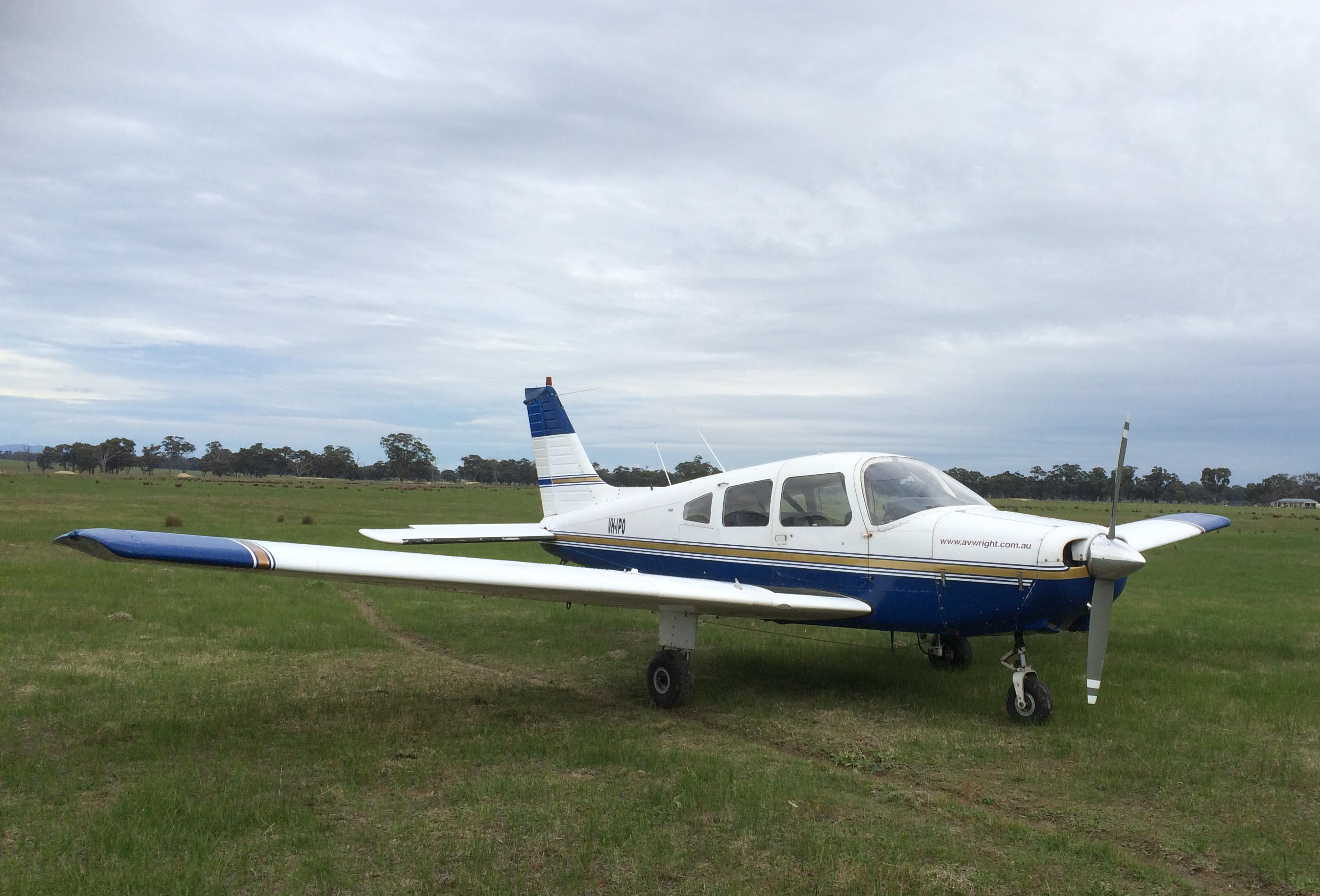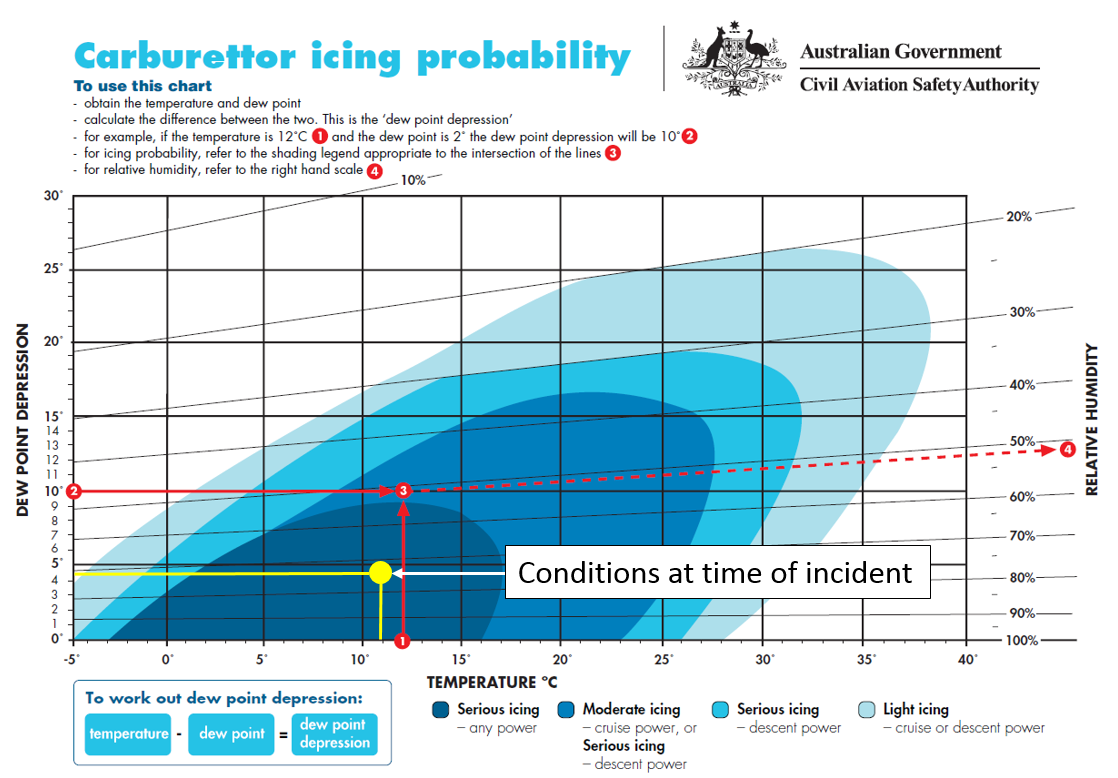What happened
On the morning of 16 June 2016, a student and instructor planned to conduct a training flight in a Piper PA-28-161 aircraft, registered VH-IPO (IPO), from Mangalore Airport, Victoria.
The planned flight included time in the Mangalore training area before returning to the airport for circuit training. The aircraft departed Mangalore at about 0940 Eastern Standard Time (EST).
After completing the planned training area manoeuvres, the instructor conducted an orbit and asked the student to identify significant geographical points within the training area. At this time, the instructor noticed the tachometer indicated a slightly lower engine power output than expected for the selected throttle position. The instructor suspected carburettor icing[1] and applied carburettor heat.[2] This resulted in an immediate further drop in power and the instructor also reported the engine running slightly rough. After 10–15 seconds the power level returned to normal. After a further 10–15 seconds, the instructor selected the carburettor heat off and instructed the student to return to Mangalore. During the return flight, the instructor periodically applied carburettor heat without further indications of carburettor icing.
As the aircraft descended to Mangalore, the student selected carburettor heat on and joined the circuit for runway 36. Due to traffic in the circuit, the student conducted two go-arounds.[3] After the second go-around, the aircraft re-joined the circuit, and the student prepared the aircraft for another approach. As the student prepared to turn onto the base leg, they applied the carburettor heat. At that time, the instructor observed a large drop in RPM. The instructor then took control of the aircraft and immediately turned onto the base leg. During the turn, the engine failed, and the instructor continued the turn to track directly to runway 36. The instructor carried out the engine failure checklist, but was unable to restart the engine. The instructor then broadcast MAYDAY[4] on the Mangalore common traffic advisory frequency.
As the aircraft descended toward runway 36, the instructor assessed that they did not have sufficient altitude to glide to the runway. The instructor identified a field to the south of runway 36 and outside of the airport perimeter as suitable for a forced landing. As the aircraft descended through about 200 ft above ground level, the instructor conducted the shutdown checklist and landed the aircraft in the selected field.
The instructor and student were not injured in the incident and the aircraft was not damaged.
VH-IPO

Source: Aircraft operator
Operator comment
The operator of IPO provided the following comment:
An engineer inspected the aircraft after the incident. The exhaust system, engine controls, fuel system and ignition system were inspected. Engine tests and a flight test were also performed. All checks indicated no faults with the aircraft or contaminants in the fuel system.
Carburettor icing
Induction icing, often referred to as carburettor icing, is the accumulation of ice within the induction system of an engine fitted with a carburettor. This ice forms as the decreasing air pressure and introduction of fuel reduces the temperature within the induction system. The temperature may reduce sufficiently for moisture within the air to freeze and accumulate. This build-up of ice restricts airflow to the engine, leading to a reduction in engine performance.
Environmental conditions influence the likelihood of carburettor ice forming, as shown by the Civil Aviation Safety Authority (CASA): Carburettor icing probability chart.
On the morning of the engine failure, the Mangalore aerodrome weather information service reported the following weather conditions.
Table 1: Weather conditions at Mangalore Airport on 16 June
| Time | Temperature | Dew point |
| 1000 | 8.6 °C | 8.6 °C |
| 1015 | 9.4 °C | 9.1 °C |
| 1030 | 9.6 °C | 7.5 °C |
| 1045 | 10.1 °C | 7.3 °C |
| 1100 | 10.6 °C | 6.9 °C |
| 1115 | 10.9 °C | 6.5 °C |
The carburettor icing probability chart shows the conditions at Mangalore Airport placed IPO in the serious icing zone for carburettor icing at the time of the incident (Figure 1). Carburettor icing could be expected at any power setting.
Figure 1: Carburettor icing probability chart showing prevalent conditions in yellow

Source: CASA modified by ATSB
The first indication of carburettor icing is normally a reduction in power produced by the engine. If not corrected by the pilot this may lead to rough running of the engine and engine failure.
When operating in conditions conducive to carburettor icing, pilots should use carburettor heat to prevent and remove ice build-up. After selecting carburettor heat, engine performance may deteriorate further as the ice is melted before engine performance returns to normal. This may take up to 30 seconds.
Instructor comment
The instructor of IPO provided the following comments:
On the two circuits prior to the engine failure, the student selected carburettor heat on prior to turning onto the base leg of the circuit with no indications of carburettor icing.
After the second go-around, the student joined a shortened downwind. The time period when the carburettor heat was selected off, where the carburettor ice appeared to form was very short and occurred at a very high-power setting.
Safety action
Whether or not the ATSB identifies safety issues in the course of an investigation, relevant organisations may proactively initiate safety action in order to reduce their safety risk. The ATSB has been advised of the following proactive safety action in response to this occurrence.
Aircraft operator
As a result of this occurrence, the aircraft operator has advised the ATSB that they are taking the following safety actions:
- The operator has increased instructor and student awareness of carburettor icing probability and symptoms for early detection. The operator has issued all instructors and students with a copy of the CASA article Ice kills.
- The operator will review relevant company briefs to include carburettor ice probability and prevention.
- The operator has recommended the company operations manual be reviewed to mitigate against flying outside of gliding distance to the runway during circuit training.
Safety message
This incident highlights the insidious nature of carburettor icing and the speed with which carburettor icing can occur in favourable environmental conditions. The incident also reinforces the need for pilots to be aware of the risk of carburettor icing at all times during the operation of aircraft fitted with a carburettor.
- The ATSB article Melting moments: Understanding carburettor icing provides valuable information to assist pilots in understanding and preventing carburettor icing.
- The article Piston engine icing produced by the European Strategic Safety Initiative provides in-depth information to assist pilots in identifying and managing carburettor icing.
Aviation Short Investigations Bulletin- Issue 52
Purpose of safety investigationsThe objective of a safety investigation is to enhance transport safety. This is done through:
It is not a function of the ATSB to apportion blame or provide a means for determining liability. At the same time, an investigation report must include factual material of sufficient weight to support the analysis and findings. At all times the ATSB endeavours to balance the use of material that could imply adverse comment with the need to properly explain what happened, and why, in a fair and unbiased manner. The ATSB does not investigate for the purpose of taking administrative, regulatory or criminal action. TerminologyAn explanation of terminology used in ATSB investigation reports is available here. This includes terms such as occurrence, contributing factor, other factor that increased risk, and safety issue. Publishing informationReleased in accordance with section 25 of the Transport Safety Investigation Act 2003 Published by: Australian Transport Safety Bureau © Commonwealth of Australia 2016
Ownership of intellectual property rights in this publication Unless otherwise noted, copyright (and any other intellectual property rights, if any) in this report publication is owned by the Commonwealth of Australia. Creative Commons licence With the exception of the Coat of Arms, ATSB logo, and photos and graphics in which a third party holds copyright, this publication is licensed under a Creative Commons Attribution 3.0 Australia licence. Creative Commons Attribution 3.0 Australia Licence is a standard form licence agreement that allows you to copy, distribute, transmit and adapt this publication provided that you attribute the work. The ATSB’s preference is that you attribute this publication (and any material sourced from it) using the following wording: Source: Australian Transport Safety Bureau Copyright in material obtained from other agencies, private individuals or organisations, belongs to those agencies, individuals or organisations. Where you wish to use their material, you will need to contact them directly. |
__________
- Carburettor ice is formed when the normal process of vaporising fuel in a carburettor cools the carburettor throat so much that ice forms from the moisture in the airflow which can restrict the airflow and interfere with the operation of the engine.
- Carburettor heat is a system within the aircraft engine, selectable by the pilot, which draws heated air into the carburettor to prevent or attempt to remove ice.
- Go-around, the procedure for discontinuing an approach to land, is a standard manoeuvre performed when a pilot is not completely satisfied that the requirements for a safe landing have been met. This involves the pilot discontinuing the approach to land and may involve gaining altitude before conducting another approach to land.
- MAYDAY is an internationally recognised radio broadcast for urgent assistance.


